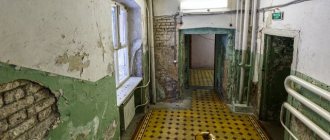According to the data available to the Ministry of Construction of the Russian Federation, at the end of 2019 in our country there were more than 54 thousand multi-apartment residential buildings that were recognized as dangerous for living in them. According to rough estimates, this is about 16 million square meters of living space, where hundreds of thousands of citizens live.
Emergency housing is not only characterized, as a rule, by the lack of necessary communications and a low level of comfort for life, but also by a significant danger for residents, since the breakdown of the house implies colossal wear and tear on the main structural elements of the building.
In this regard, federal and regional authorities are carrying out systematic legislative and practical work to quickly resettle emergency housing and reduce their share in the housing stock.
The legislative framework
Issues related to the resettlement of unsuitable housing are very complex from the point of view of organizing this process on a national scale. In this regard, their legal regulation should be comprehensive, considering both the intricacies of their financial support and the procedural procedure for carrying out the relevant work on the ground.
So, the main legal document that regulates the process of resettlement of emergency housing in terms of raising financial resources for these purposes is the federal law “On the Fund for Assistance to the Reform of Housing and Communal Services” No. 185-FZ , which was adopted back in 2007.
In accordance with this legal act, a special state fund was created, the task of which is to accumulate budget funds to resolve issues related to the overhaul of residential buildings and the resettlement of apartment buildings that are recognized as unsafe. This legal document determines the procedure for financing various targeted programs, both federal and regional, which are aimed at eliminating uninhabitable apartment buildings.
In addition, the housing rights of citizens during resettlement are established by the norms of the Housing Code of the Russian Federation. In particular, it has been established that residents of buildings and structures seized for demolition must receive residential premises of similar size. And if the tenant was the owner, then in this case he has the right to choose whether to receive a new apartment or count on adequate monetary compensation.
Issues directly related to the procedure for declaring a building unsuitable for further residence, including the corresponding procedure and timing of resettlement, are considered by a special Regulation approved by Decree of the Government of the Russian Federation No. 47 of January 28, 2006.
Reference! Existing resettlement programs, developed taking into account the designated legal acts, apply exclusively to residents of multi-apartment residential buildings.
Citizens who live in individual houses bear the burden of maintaining it exclusively at their own expense. In addition to the legal acts presented above, there are a large number of other regulatory, technical and methodological documents that affect certain aspects related to the resettlement of emergency housing.
Stage four: receiving compensation for emergency housing
The administration must send the owner an agreement that specifies the terms of the purchase. If she does not send this agreement or the indicated amounts are not satisfactory, then you can order an appraisal examination and go to court.
The redemption price includes the market value of the residential premises, compensation for major repairs not carried out, losses associated with relocation, and other things. More details can be found in paragraph 7. Art. 32 Housing Code of the Russian Federation.
Example solution HERE.
State resettlement programs
To quickly resolve issues related to the modernization of the housing stock in the Russian Federation, a special federal project was developed with a validity period until 2025, which involves a significant increase in funding for the regions in terms of relocating citizens from emergency apartments.
At the same time, funds are sent to the constituent entities of the federation on the basis of special programs. The procedure for their formation is determined by Article 16 of Federal Law No. 185-FZ.
In particular, it has been established that the use of federal funds is the responsibility of the regions. The necessary financing is carried out, in fact, at the request of the constituent entities of the federation, called the “regional targeted program for the resettlement of citizens from emergency housing stock.”
This document is formed and approved by the administration of the subject of the federation and must contain, among other things, the following:
- list of apartment buildings (with addresses);
- the timing of the resettlement of citizens from the specified apartment buildings into new comfortable houses;
- the amount of federal funding required, as well as available funds allocated for these purposes by the regional budget, as well as other sources;
- justification of the need to attract federal funds.
Important! The national resettlement program involves, for the most part, shared financing - both from the federal and regional (local) budgets.
Information regarding regional programs is not confidential and is available for study on the websites of local authorities of a particular region of the Russian Federation. In addition, you can get up-to-date information about the number of apartment buildings subject to demolition, plans for the inclusion of one or another apartment building in the program, as well as about houses already occupied on the Housing and Communal Services Reform website, located at the web address: https://www.reformagkh .ru.
Criteria for dilapidation and disrepair of housing
The concept of “emergency housing” is disclosed in the relevant Regulations approved by Decree of the Government of the Russian Federation on January 28, 2006 No. 47.
Among other things, this document contains criteria by which an apartment building can be recognized as an emergency.
- Physical wear and tear and impossibility of reconstruction. All erected structures and buildings wear out over time and lose their operational properties. However, physical wear and tear in itself is not a criterion for recognizing a house as unsafe as such. An apartment building unsuitable for living has significant wear and tear on the floors, foundations and load-bearing walls, combined with the impossibility of carrying out restoration work.
- Damage to a home as a result of a man-made or natural event. If a residential building was damaged as a result of a natural emergency or an explosion, fire, or collapse, a special commission evaluates the possibility of carrying out restoration work. If the latter are impractical, then the apartment building is considered unsafe and subject to demolition.
A house may be considered unsafe even if the physical wear and tear is not so great. The reason for this may be the location of the building in an area that is susceptible to various natural disasters.
In addition to emergency housing, “dilapidated housing” is also highlighted . It should be understood as a multi-unit building with a significant process of wear and tear of the main structural elements of the building (for wooden buildings - 65%, for stone ones - 70%). However, when living in dilapidated housing there is no danger to the life and health of citizens, which distinguishes it from emergency housing.
Who is responsible for emergency housing?
Your property is your problem. This statement in the context of the issue under consideration is incorrect. Owners of dilapidated housing have Art. 32 Housing Code of the Russian Federation. It sets out in sufficient detail (albeit very confusingly) their rights in the event that the premises are declared unfit for habitation.
Just a few years ago, the provisions of this article were taken extremely seriously by the courts. I believe the reasons for this will be clear from the following.
Let's take a closer look at the question of how to get money for emergency housing. The entire procedure is fully described in Art. 32 Housing Code of the Russian Federation. It consists of separate stages.
Options for relocating from dilapidated houses
Current legislation provides for the following forms of resettlement of residents of emergency buildings:
- Provision of other residential premises in new houses that were built within the framework of this target program or purchased from developers for these purposes.
- Payment of monetary compensation for the owner of an apartment in a dilapidated building to purchase housing independently.
- Providing subsidies for acquisition or construction.
Housing legislation presupposes that new housing must be equal in area to the one being withdrawn, and also be suitable for living, which includes providing the necessary communications and finishing the premises. In addition, housing is issued within the same municipal area where the emergency house was located. In some cases, it is possible to issue an apartment in another municipality (district), but only with the consent of the citizen.
Third stage: decision to seize
The administration makes and sends to the owner a decision to seize the land plot on which the dilapidated residential building is located. The land plot is confiscated, and, consequently, the emergency house and all the individual premises located in it are confiscated.
The administration is inactive - again we file an administrative claim. Requirement: “to recognize the inaction of the Administration of _______________ as illegal and to oblige the Administration of __________, no later than one month from the moment the court decision enters into legal force, to make a decision on the seizure for municipal needs of the land plot on which the residential building _______________ is located and, accordingly, make a decision on the seizure premises owned by ______, located at the address: ______________________, determining the redemption price of the seized residential premises, terms and other conditions of redemption.”
Example solution HERE.
Relocation procedure
If the house is in a regional targeted program, then resettlement will not be carried out immediately, but in several stages and according to certain rules:
- Notifying owners about the start of construction work. The local administration is obliged to notify residents of the start of the actual resettlement procedure at least one year in advance.
- Providing documents to the local administration to obtain new housing or compensation. Residents of the house provide identification documents and title documents to the administration, on the basis of which they will subsequently be allocated new housing.
- Moving out of your old home. In accordance with the direction of the municipality, residents move into new apartments. However, there are often situations when the apartment building being built for them is under construction, so during this period citizens can be relocated to temporary housing of a flexible fund.
- Obtaining ownership rights. After moving into new apartments, residents need to register ownership of housing in Rosreestr. For persons living under social rent, there is an obligation to conclude a new contract.
What amount is given?
For every apartment owner, the amount of compensation is considered a significant issue. The law requires taking into account the market value of objects, but often citizens are faced with a more primitive and incorrect calculation.
To do this, a comparative assessment methodology is used, which is divided into several stages:
- similar real estate properties located in the region are selected;
- the average price per 1 sq. is determined. m.;
- due to the use of a reduction factor, the value is reduced, for which the condition of the property is taken into account, and such a reduction varies from 10 to 50 percent;
- the resulting value is multiplied by the square area of the apartment.
Attention! If a citizen owns not only housing, but also a plot of land, then only a small amount is added, which does not take into account the real value of the land.
With such calculations, citizens receive too small an amount, which is not enough to buy a new home. Therefore, they have to sue representatives of the municipality, proving their case in court.
Based on judicial practice, which was approved by the Presidium of the Supreme Court, not only the cost of emergency housing or a plot of land is compensated, but also the market price without taking into account wear and tear, as well as losses that a citizen has to bear when changing his place of residence. If during this process a person rented housing, used cargo transportation services, or spent funds for other purposes, then they are reimbursed by the state.
If the house is not recognized as dilapidated, but the residents cannot live due to unsuitable living conditions
If residents do not know whether their home is participating in a relocation program, the first step is to find out if this is the case. To do this, you can submit an official request to the municipal administration or obtain information on the Housing and Communal Services Reform website.
If the house does not participate in the program, then residents must do the following:
- Submit a collective application to the municipality to recognize the house as unsafe.
- Wait for the formation of an interdepartmental commission.
- Wait for the conclusion of the interdepartmental commission.
At this stage, the house may be considered either dilapidated or in disrepair. In the first case, residents have the right to count on major repairs (with a possible temporary move to a flexible building). If the housing is recognized as unsafe, then the residents are given an approximate time frame for relocation, after which the house is included in the appropriate register.
If residents do not agree with the decision of the interdepartmental commission, then they have the right to challenge it in court. However, to do this, it is first necessary to conduct an independent examination that will confirm the tenants’ arguments.
Citizens who are owners have the right to expect compensation instead of providing housing. To do this, they need to send a corresponding application to the municipality, which is considered within 5 days. If the decision is positive, then an agreement on the transfer of property is concluded with the municipality, after which the person leaves the apartment and receives compensation to a bank account.
Attention! Tenants are required to provide confirmation of the number of family members before moving in. During the period of relocation, a new social rental agreement is concluded between the municipality and the tenant, on the basis of which it is possible to live in the new living space.
What to do if you refuse
If representatives of the local administration insist that citizens receive new apartments, refusing to issue compensation, then this issue is resolved in court. It is also necessary to go to court if a monetary payment is too small.
Officials deliberately underestimate the price, so it is advisable to conduct an independent examination to find out the exact market price of the object without taking into account wear and tear. The report is submitted to the judge, after which the claims are usually satisfied, so the local administration is forced to pay the due amount to citizens.
Popular questions and answers
Question: Is it legal for the administration to demolish the house on its own?
Answer: Due to certain articles of housing legislation, residents have the right to demolish their house on their own. However, if this is refused, the municipality is obliged to do so at its own expense.
Question: Is it legal for the administration to move to flexible housing stock after eviction from old apartments?
Answer: In some cases, when living in an apartment building poses a real danger, the administration may begin resettlement on an accelerated basis. And if the new housing is not ready, the residents will be relocated to a flexible housing stock.
Question: Is it possible to sell an apartment in a building recognized as unsafe?
Answer: The owner has the right to carry out purchase and sale transactions of real estate in an emergency apartment building in the absence of encumbrances.
When should residents of an emergency building be notified and moved out?
Every person wants to move from a dilapidated house in a timely manner, so you should understand the main timing of this process.
If, as a result of an investigation of a house by an interdepartmental commission, it is decided that the building can no longer be used for living, then citizens will be required to leave such a house literally within 24 hours.
What is the procedure for relocating emergency housing? Read here.
As a rule, residents of the house are warned in advance about relocation. Photo: mosaica.ru
Important! An emergency evacuation is carried out if it turns out that the destruction of a structure may occur at any moment or other situations may arise in which people may suffer.
If there is a standard case, then after the house is recognized as unsafe, each tenant in it receives a notice indicating the need to evict within a period of five days. By law, this period may be increased, but cannot exceed one year.
How long does it take to relocate?
By law, this process must be completed within five days, but practice shows that it often takes up to one year.
Often, even for years, unsuitable housing for permanent residence of people is used. This is due to various facts, for example, the lack of suitable housing at the municipality or the reluctance of citizens to move.
The law does not have a strictly defined definition of which house can be considered suitable for habitation and which cannot.
For example, if there are numerous damages to the facade and high-quality communication networks, major repairs will be ordered, and in this case it is not always even necessary to temporarily evict the residents.
If it turns out that living in such a building may cause a danger to the life or health of people, then citizens must contact the commission themselves to have an inspection carried out. Based on it, a conclusion is made about the condition of the house.
In practice, resettlement periods often extend for years. Watch the video:
Other documents must be attached to the application:
- technical certificate of the building;
- acts received from the SES and fire inspection;
- acts confirming that regular inspections of the structure were carried out;
- certificates and applications for an inspection by housing inspectors, which confirms that the building is indeed in disrepair and dilapidated.
Once a house is included in the list of buildings subject to demolition, it is no longer allowed to sell apartments in it. After this, other apartments for citizens will be promptly found.









